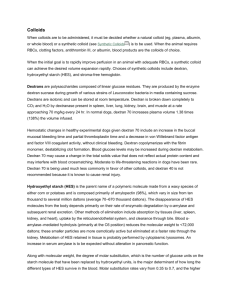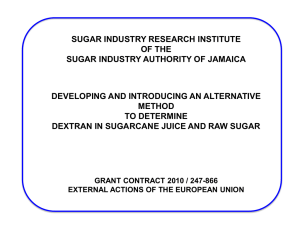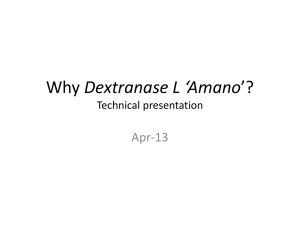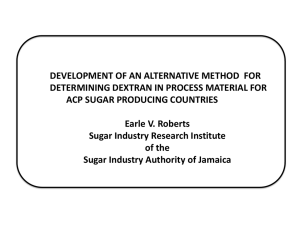Coagulation competence for predicting perioperative hemorrhage in
advertisement
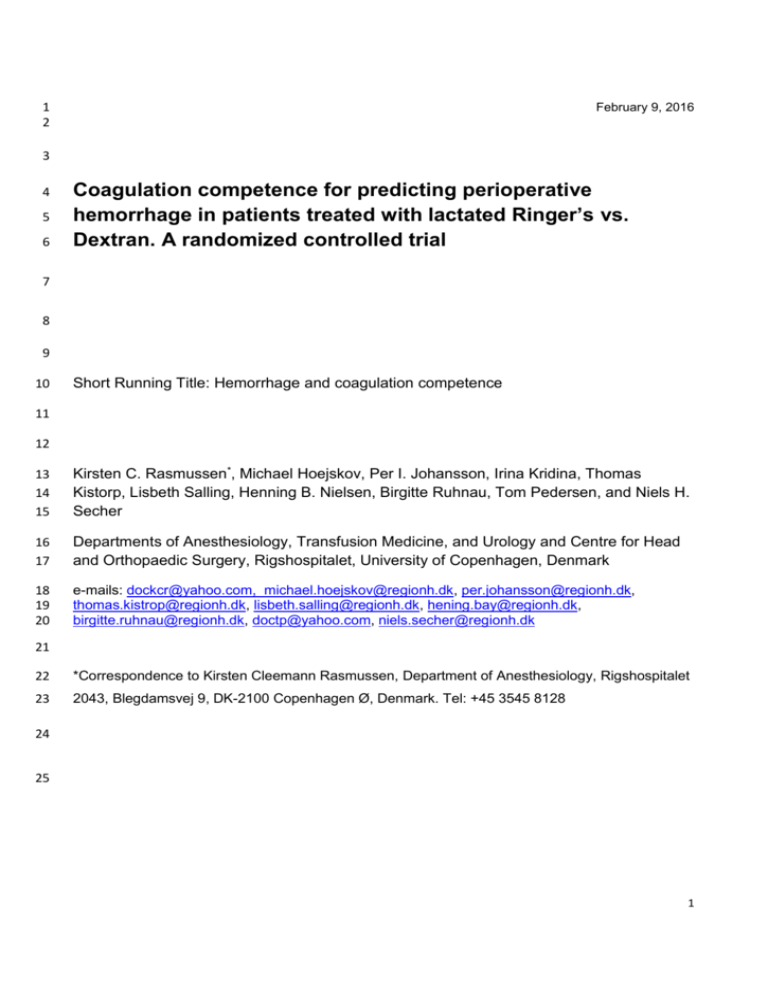
1 2 February 9, 2016 3 4 5 6 Coagulation competence for predicting perioperative hemorrhage in patients treated with lactated Ringer’s vs. Dextran. A randomized controlled trial 7 8 9 10 Short Running Title: Hemorrhage and coagulation competence 11 12 13 14 15 Kirsten C. Rasmussen*, Michael Hoejskov, Per I. Johansson, Irina Kridina, Thomas Kistorp, Lisbeth Salling, Henning B. Nielsen, Birgitte Ruhnau, Tom Pedersen, and Niels H. Secher 16 17 Departments of Anesthesiology, Transfusion Medicine, and Urology and Centre for Head and Orthopaedic Surgery, Rigshospitalet, University of Copenhagen, Denmark 18 19 20 e-mails: dockcr@yahoo.com, michael.hoejskov@regionh.dk, per.johansson@regionh.dk, thomas.kistrop@regionh.dk, lisbeth.salling@regionh.dk, hening.bay@regionh.dk, birgitte.ruhnau@regionh.dk, doctp@yahoo.com, niels.secher@regionh.dk 21 22 *Correspondence to Kirsten Cleemann Rasmussen, Department of Anesthesiology, Rigshospitalet 23 2043, Blegdamsvej 9, DK-2100 Copenhagen Ø, Denmark. Tel: +45 3545 8128 24 25 1 1 Abstract 2 Background: Perioperative hemorrhage may depend on coagulation competence and this 3 study evaluated the influence of coagulation competence on blood loss during cystectomy 4 due to bladder cancer. 5 Methods: Forty patients undergoing radical cystectomy were included in a randomized 6 controlled trial to receive either lactated Ringer’s solution or Dextran 70 (Macrodex ®) that 7 affects coagulation competence. 8 Results: By thrombelastography evaluated coagulation competence, Dextran 70 reduced 9 “maximal amplitude” (MA) by 25% versus a 1% reduction with the administration of 10 lactated Ringer´s solution (P<0.001). Blinded evaluation of the blood loss was similar in 11 the two groups of patients - 2339 ml with the use of Dextran 70 and 1822 ml in the lactated 12 Ringer’s group (P=0.27). Yet, the blood loss was related to the reduction in MA (r=-0.427, 13 P=0.008) and by multiple regression analysis independently associated with MA (P=0.01). 14 Thus, 11 patients in the dextran group (58%) developed a clinical significant blood loss (> 15 1500 ml) compared to only 4 patients (22%) in the lactated Ringer’s group (P=0.04). 16 Conclusions: With the use of Dextran 70 vs. lactated Ringer’s solution during cystectomy, 17 a relation between hemorrhage and coagulation competence is demonstrated. Significant 18 bleeding develops based on an about 25% reduction in thrombelastography determined 19 maximal amplitude. A multivariable model including maximal amplitude discriminates 20 patients with severe perioperative bleeding during cystectomy. 21 Trial registration: The study was accepted on January 7th, 2013 at the 22 clinicaltrialsregister.eu EudraCT 2012-005040-20. 2 1 Key words: Coagulation, Colloid, Crystalloid, Fluid therapy, Hemorrhage 2 3 Introduction 4 For patients exposed to a massive blood loss, maintained coagulation competence is 5 important [1-3]. It is less clear whether coagulation competence influences bleeding during 6 elective surgery. During surgery the circulation is supported by crystalloids, but about 30% 7 of the administered volume is “lost” to the interstitial space even when the circulating blood 8 volume is reduced due to hemorrhage [4]. It therefore remains an option to administer a 9 colloid to patients during major surgery because a colloid stays within the circulation and 10 may even recruit fluid to the vasculature. Yet, it is a concern that synthetic colloids impair 11 coagulation competence by reducing clot propagation and strength by affecting 12 polymerization of fibrinogen [5-7]. 13 We evaluated the importance of coagulation competence for the perioperative 14 blood loss during cystectomy. The first part of this evaluation used Hydroxyethyl Starch 15 (HES 130/0.4) vs. lactated Ringer’s solution (LR) and demonstrated a doubling of the 16 perioperative blood loss [8]. Here we used Dextran 70 vs. LR to manipulate coagulation 17 competence during cystectomy to evaluate whether the perioperative blood loss is related 18 to reduction in coagulation competence as determined by thrombelastography (TEG). Also 19 the design of the study allowed for comparison of the use of Dextran 70 and LR on patient 20 outcome and the cost associated with administration of volume. 3 1 Methods 2 This randomized controlled trial was based on plasma collected from participants in a 3 colloid vs. crystalloid trial [8]. The study was approved by Rigshospitalet, University of 4 Copenhagen, after approval had been obtained from the ethics committee in the Capital 5 Region of Denmark (H-1-2012-135), and registered at www.clinicaltrialsregister.eu with 6 Trial Registration Number EudraCT 2012-005040-20. The trial was monitored by the 7 Agency for Good Clinical Practice at the University of Copenhagen and the Declaration of 8 Helsinki criteria were followed [9]. Conduct of the trial and safety of the participants were overseen by the 9 10 authors who gathered the data that remained confidential throughout the process. The 11 authors were involved in all stages of manuscript generation and vouched for 12 completeness and accuracy. No third party influenced the study design, data analysis, or 13 reporting. 14 Screening and randomization took place between February 12th 2013 and July 15 8th 2014. At least 24 h before surgery written informed consent was obtained from the 16 patients. We excluded patients from this investigator-initiated, prospective, blinded trial if 17 consent was withdrawn. Forty out of 99 patients scheduled for elective cystectomy were 18 randomized to receive the recommended maximum volume (25 mL/kg) of either 6% 19 Dextran 70 (Macrodex®, Meda AB, Solna, Sweden) or LR by computer-generated 20 allocation sequence (Figure 1). We included patients older than 18 yrs. scheduled for 21 elective open cystectomy with no history of heart or hepatic insufficiency, disability of 22 coagulation, intra-cerebral hemorrhage, or hemodialysis. If a patient used medication that 4 1 was considered to affect coagulation competence, that medication was paused five days 2 prior to surgery according to national guidelines. 3 Interventions 4 The patients were allowed to eat solid foods up to 6 h and to drink clear fluids until 2 h 5 before surgery. An IV line was established and flushed with the randomized fluid placed in 6 an opaque bag to blind the surgical nurse who recorded the volume of lost blood. After 7 induction of anesthesia a catheter was placed in the radial artery of the non-dominant arm 8 and connected to a Nexfin monitor (Bmeye B.V, Amsterdam, The Netherlands). From the 9 blood pressure curve, Nexfin estimates a beat-to-beat stroke volume (SV) and thereby 10 cardiac output (CO) by use of a non-linear three-component model of arterial impedance 11 as evaluated by modified Modelflow technology [10]. 12 For induction of anesthesia remifentanil infusion (0.5 µg kg-1 min-1) was 13 initiated and when the patient reported sedation propofol (2.0 mg kg-1) was administered. 14 Propofol (5-10 mg kg-1 h1) and remifentanil (1.75-2.25 mg h-1) were used to maintain 15 anesthesia. In the horizontally placed patient normovolemia was established, i.e. it was 16 secured that after eventual repeated administration of 200 mL of the randomized fluid, SV 17 increased by less than 10% according to “goal directed fluid therapy” (GDT) criteria [11]. 18 Heart rate (HR), mean arterial pressure (MAP), SV, and CO were determined 19 after induction of anesthesia and insertion of the arterial catheter (T1), after resection of the 20 urinary bladder (T2), at the end of surgery (T3), and two hours thereafter in the recovery 21 room (T4). If systolic pressure was below 80 mmHg, 5 to 10 mg of ephedrine was 22 administered. Arterial blood was analysed by TEG: clot initiation (R-time), rate of 23 development (Angle), formation (maximal amplitude, MA), and lysis after 30 min (Ly30) 5 1 depicting hemostatic competence (TEG 5000, Haemoscope Corporation, Niles, IL) [12]. 2 We also analysed blood for hemoglobin, creatinine, international normalised ratio (INR), 3 platelets, dimer, and fibrinogen. Furthermore, blood was drawn from the central venous 4 catheter for lactate and blood gas variables (ABL 825, Radiometer, Copenhagen, 5 Denmark). 6 To avoid excessive administration of Dextran 70, both groups of patients 7 received either LR or 5% Human Albumin (HA) if considered in need by the anesthetist 8 after infusion of the allocated fluid (non-study fluid). Fluid balance was determined at T2, T3, 9 and T4. Two surgeons who together had completed more than 1100 cystectomies carried 10 11 out the procedures. The primary outcome variables were coagulation competence and the 12 perioperative blood loss. We also compared the use of dextran or LR on patient outcome 13 defined as a straight postoperative track: length of hospital stay ≤ 7 days without 14 complications requiring treatment and on the cost associated with fluid administration to 15 support the circulation. 16 Cost-Effectiveness Analysis 17 The cost-effectiveness ratio is defined as the cost (C) per successfully treated patient (E), 18 i.e., cost to keep a patient free of complications. The cost-effectiveness analysis used the 19 difference in cost divided by the difference in benefit (C/E) [13] based on the 2015 price 20 (Data-Ware-House ®, Rigshospitalet) for Dextran 70 (4.51 $ per 500 ml), LR (1.19 $ per 21 1000 ml), packed red blood cells (46.84 $ per 250 ml), and HA (15.60 $ per 250 ml). 22 6 1 Statistical Methods 2 Patients were analysed in the group to which they were assigned (Table 1). The sample 3 size calculation was based on data from a study comparing the effect on hemorrhage 4 during cystectomy with the use of HES 130/0.4 vs. LR [8]. The blood loss was 2181 5 vs.1370 ml with a SD of 1190 vs. 603 ml [8]. The study was powered to detect a difference 6 in blood loss of 800 ml between administration of Dextran 70 and LR with a two-sided 7 alpha level of 0.05 and a power of 80% for t-test with correction for multiple comparisons. 8 Consequently, a sample size of 20 patients per group was included. 9 The statistical analyses were performed before breaking the randomization 10 code and data were analysed from the modified intention-to-treat population, defined as all 11 randomly assigned patients except those who could be excluded without the risk of bias 12 (Figure 1). We used two-sided or unadjusted chi-square tests with odds ratio (OR) and t- 13 test and Fisher’s exact test for continuous and dichotomous variables, respectively (SPSS 14 version 20.0). Test for differences were performed using Pearson’s test, χ2 test for 15 categorical data, and analysis of variance or Mann-Whitney U-test and Wilcoxon signed 16 ranks test for continuous data when appropriate. Means and standard deviation (SD) or 17 confidence interval (CI) are given, For possible determinants of perioperative bleeding, 18 multiple logistic regression analysis defined variables from TEG and plasma hemostatic 19 analyses that were independently associated with severe intraoperative bleeding (> 1.5 l). 20 Also receiver operating characteristic (ROC) curves were used to predict 21 perioperative bleeding. Areas under the ROC curve with the 95% confidence Intervals (CI) 22 were calculated. Optimal cut-points were obtained by minimizing the distance between the 7 1 ROC curve and the upper left corner of the curve. Results are presented with 95% CI and 2 a two-sided P value < 0.05 was considered to indicate statistical significance. 8 1 Results 2 Patients were randomized into two groups (Figure 1). There was no significant intergroup 3 difference in baseline data including preoperative disease among patients (Table 1). After 4 induction of anesthesia, 5 patients (26%) in the colloid group were intravascular 5 hypovolemic according to GDT criteria as compared to 7 patients (39%) in the crystalloid 6 group, P=0.495. In the colloid group patients received 24 (18 to 25) ml kg-1 Dextran 70 7 since 3 patients were considered to be hemodynamic stable before the intended volume 8 (25 ml kg-1) was infused. 9 The perioperative blood loss was 2339 (1630 to 3048) ml in the colloid group and not 10 significantly different in the LR group: 1822 (1160 to 2484) ml, P=0.2 (Table 2). Yet, more 11 patients in the dextran than in the LR group were exposed to clinical severe hemorrhage: 12 58% vs. 22% lost more than 1500 ml blood, OR= 4.8 (1.1 to 20.2), P=0.04. In the LR 13 group, one significant bleeding episode (5.5 l) was because of injury to the common iliac 14 vein and in this case hemorrhage cannot be ascribed to coagulation competence. If that 15 patient is eliminated from the analysis, the loss of blood was 2339 (1630 to 3048) ml vs. 16 1610 (1090 to 2130) ml in the dextran and LR group, respectively, P=0.048. Table 2 also 17 presents IV administration of study as well as non-study fluids. Transfusion was initiated at 18 a hemoglobin of 4.9 mmol l-1 and the transfusion of packed red blood cells was 597 (302 to 19 893) vs. 313 (42 to 584) ml (P=0.14) in the Dextran 70 and LR group, respectively. Thus, 20 12 patients (63%) in the colloid group were provided with blood vs. 5 patient (28%) in the 21 crystalloid group, OR=4.5 (1.1 to 17.9), P=0.04. The fluid balance was positive by 1520 22 (1198 to 1842) ml in the dextran group and by 1925 (1580 to 2272) ml in the LR group 23 (P=0.03) also with more patients in the RL group having a positive fluid balance exceeding 24 1500 ml, 78% vs. 21%, OR=13.1 (2.7 to 62.8) P=0.001. The dextran group received 17 mg 9 1 ephedrine and the LR somewhat more (29 mg, P= 0.03) resulting in no differences in 2 MAP, SV or CO between the two groups of patients. 3 Table 3 presents results from TEG analyses. The lowest values of RT, Angle and MA in 4 the analyses was observed in the dextran group at the end of anesthesia (P<0.001). 5 Platelets values decreased in both groups during anesthesia (from 205±69 to 141±45 109/l 6 in the dextran group, P<0.001, and from 243±65 to 198±72 109/l in the LR group) P<0.001, 7 whereas dimer increased similarly in both groups (from 0.59±0.50 to 1.08±0.57 mg/l 8 (dextran group) and from 0.38±0.12 to 1.18±0.65 µmol/ l (LR group); P<0.001). 9 Hemoglobin decreased more (5.2±0.6 vs. 6.1±0.9 mmol/l) in the dextran group compared 10 to the LR group, P<0.001. 11 The blood loss was related to the decrease in MA (r=-0.407 (95%CI -0.632 to -0.101) 12 P=0.008 (Figure 2), but not to R-time, Angle, or Ly30. Univariate analyses defined four 13 TEG variables (Table 3) important for a blood loss > 1.5 l and included in a multiple logistic 14 regression analysis. Concerning the influence of the coagulation variables as predictors for 15 what was considered a significant blood loss (> 1.5 l), only MA was important (Table 4). 16 Thus, MA was used to build a ROC curve for patients receiving Dextran 70 or RL with a 17 blood loss > 1.5 l. The areal under the curve (AUC) was 0.69 (0.51–0.87) and the optimal 18 cut-point for MA was 81% of the value at T1 (about 52 mm), providing 80% sensitivity and 19 53% specificity (P=0.04) equating a likelihood ratio (sensitivity/1-specificity) = 1.90 (Figure 20 3). 21 Creatinine increased (>120 mol l-1) at the end of surgery for 5 patients (26%) in the dextran 22 group compared with normal values in the LR group (P=0.046), but no participant was in 23 need of hemodialysis. Also in the LR group 61% of the patients had a postoperative 10 1 straight track compared to only 21% in the dextran group, OR=5.9, 95%CI (1.38 to 25.23), 2 P=0.02 (Table 1). The number of patients with at least one treated postoperative 3 complication was 7 (37%) vs. 3 (17%) (OR=2.9, 95% CI (0.6 to 13.8) P=0.26). Five (26%) 4 vs. 2 (11%) patients were re-operated in the dextran and LR group, respectively (OR=2.9, 5 95% CI (0.5 to 17.1) P=0.40). No patient needed re-operation due to intestinal dysfunction. 6 Thus, the length of hospital stay was similar among the two groups, P=0.69. 7 The cost of fluid infusions per patient was119 vs. 95 $ (Dextran 70 vs. LR), while the cost- 8 effectiveness ratio (the cost of successfully treating one patient with Dextran 70 or LR) was 9 188 (119 x 19 /12) and 114 (95 x 18/15) $ to avoid complications requiring treatment in the 10 dextran and LR group of patients, respectively. 11 11 1 Discussion 2 This randomised study used either Dextran 70 or lactated Ringer’s solution to support the 3 circulation according to individualized goal-directed principles during cystectomy to 4 evaluate the importance of coagulation competence for the perioperative loss of blood 5 [14,15]. Coagulation competence was evaluated by TEG and the perioperative blood loss 6 was related to reduction in MA by 25% Perioperative hemorrhage tended to increase when Dextran 70 rather than LR 7 8 was administered and more patients in the dextran group were exposed to a severe blood 9 loss as identified by a larger than a 1500 ml, blood loss (a class IV blood loss) and oxygen 10 transport to the tissue might become affected [16]. Furthermore, three times as many 11 patients receiving LR than dextran had a straight postoperative track supporting that 12 Dextran 70 should not be the first choice colloid for support of the circulation during major 13 surgery. 14 Dextran is used to support the circulation during major bleeding but obviously 15 with moderate administration for minor surgery administration of Dextran affects 16 coagulation competence only modestly [17]. In accordance with the CRISTAL trial 17 addressing hypotensive patients under intensive care [18], the present investigation did 18 not show significant difference in transfusion requirements between the two groups of 19 patients. Nevertheless, the transfusion requirement tended to be larger with administration 20 of Dextran 70. 21 LR reverses hypovolemia by plasma volume expansion [19]. Animal 22 experiments and computer simulation based on fluid volume kinetics suggest that initial 23 fluid volume resuscitation in a hypotensive patient may include administration of 600-750 12 1 ml of crystalloid fluid or 100 ml Dextran 70 [20]. Conversely, a positive postoperative fluid 2 balance may provoke gut edema and contribute to intestinal dysfunction, postoperative 3 complications, and extended hospital stay [21, 22, 23]. Thus it is a worry that the patients 4 provided LR received almost 50% more fluid, besides more inotrope medication compared 5 those provided with dextran, but there appeared to be no difference in complication among 6 the two group of patents. 7 If one treatment is more effective and less costly than another, that treatment 8 is considered dominant and the use of LR seems to be the dominant strategy. Equally 9 Kruer & Ensor argue that crystalloids are associated with greater effectiveness and lower 10 11 cost compared with colloids in regard to morbidity [24]. We evaluated the predictive value of TEG variables for perioperative bleeding. 12 Changes in MA in patients with blood loss > 1.5 I provides the areal under the curve on 13 0.69 besides 80% sensitivity and 53% specificity. The optimal cut-point for MA was 81% 14 (52 mm) (Figure 3) and MA was the best predictor (Table 4) to discriminate between blood 15 loss > 1.5 l or ≤ 1.5 l. In a prospective trial, 255 consecutive patients were studied to 16 compare the ability of TEG (ROTEG™) to predict postoperative blood loss, and the angle 17 was the best predictor of a blood loss >500 ml [25]. Yet, in a recent study comparing 18 hydroxyethyl starch and lactated Ringer’s during cystectomy there was correlation 19 between the perioperative blood loss and MA, with an optimal cut-point for MA on 86% (54 20 mm), resulting in 88% sensitivity and 69% specificity [8]. 21 There are limitations to this investigation: the design has a short observation period and a 22 larger cohort is needed to evaluate an effect on survival or other major outcomes. Three 23 patients were excluded from the trial after randomization (Figure 1). Furthermore, in one 24 patient hemorrhage seemed to be related to injury to the common iliac vein and one 13 1 patient was hospitalized for an exceptionally long time, both events not necessarily related 2 to the type of fluid administered. Furthermore, the different volume of albumin 3 administration in the groups may interfere with outcomes such as hospital stay and 4 postoperative complications. 5 6 Conclusion 7 With the use of Dextran 70 vs. lactated Ringer’s solution during cystectomy it is 8 demonstrated that there is a relation between hemorrhage and coagulation competence. 9 During critical bleeding there is an about 25% reduction in thrombelastography determined 10 “Maximal Amplitude”, which discriminates those with severe perioperative bleeding. Also 11 the design of the study allowed for demonstration of greater effectiveness and lower cost 12 with the use of LR compared to Dextran 70 although the length of hospital stay was equal. 13 Abbreviations 14 ASA: American Society of Anesthesiologists; BMI: Body Mass Index; FFP: fresh-frozen 15 plasma; GDT: Goal directed fluid therapy; HA: Human Albumin; LR: Lactated Ringers’ 16 solution; MA: maximum amplitude; PRBC: Packed Red Cells; ROC: Receiver Operating 17 Characteristic Curves; RT: Reaction Time; TEG: Thrombelastography 18 Competing interesents 19 The authors declare that they have no competing interests. 20 21 Authors’ contributions 14 1 K.C.R. contributed to conception and design of the study, acquisition, analysis, and 2 interpretation of presented data, drafting the article, and final approval of the version to be 3 published. M.H. contributed to acquisition, and interpretation of presented data, helped 4 draft the manuscript. P.I.J. contributed to conception and design of the study. I.K. 5 contributed to acquisition, and interpretation of presented data. T.K. contributed to 6 acquisition, analysis, and interpretation of presented data, helped draft the manuscript. 7 L.S. participated in interpretation of presented data, helped draft the manuscript. H.B.N. 8 contributed to interpretation of presented data, helped draft the manuscript. B.R. 9 contributed to conception, acquisition, interpretation of presented data, helped draft the 10 manuscript. T.P. contributed to statistical analysis, interpretation of presented data, helped 11 draft the manuscript. N.H.S. contributed to conception and design of the study, critical 12 revision of the article for important intellectual content and final approval of the version to 13 be published. 14 Acknowledgements 15 We are grateful for the skilled technical assistance analyzing blood speciments by 16 thrombelastography, and plasma coagulation variables provided by Helena Andersson and 17 the Biochemical Laboratorium, Rigshospitalet, Copenhagen, Denmark. 18 This work was supported by grants from AP Møller’s Fond, Copenhagen, Denmark, The 19 Augustinus Fond, Copenhagen, Denmark, Holger Hesses’s Fond, Denmark, Aase and 20 Ejnar Danielsen’s Fond, Lyngby, Denmark, Ove and Edith Olesen’s Legat, Denmark, and 21 by T & A Frimodt’s Fond, Denmark. 22 15 1 2 References 1. Johansson PI, Stensballe J. Hemostatic resuscitation for massive bleeding: the 3 paradigm of plasma and platelets – a review of the current literature. Tranfusion. 4 2010; 50: 701-710. 5 6 7 2. Gruen RL, Brohi K, Schreiber M,et al. Hemorrhage control in severely injured patients. Lancet. 2012;380:1099-1108. 3. Lunde J, Stensballe J, Wikkelsø A, Johansen M, Afshari A. Fibrinogen concentrate 8 for bleeding – a systematic review. Acta Anesthesiol Scand. 2014; 9 ttp://www.doi:10.1111/aas.12370. 10 11 12 13 14 4. Zaar M, Lauritzen B, Secher NH,et al. . Initial administration of hydroxyethyl starch vs. lactated Ringer after liver trauma in the pig. Br J Anaesth. 2009;102:221–226. 5. Perel P, Roberts I, Ker K. Colloids versus crystalloids for fluid resuscitation in critically ill patients. Cochrane Database Syst Rev. 2013; 2:CD000567. 6. Skhirtladze K, Base EM, Lassnigg A, et al. Comparison of the effects of albumin 15 5%, hydroxyethyl starch 130/0.4 6%, Ringer’s lactate on blood loss and coagulation 16 after cardiac surgery. Br J Anaesth. 2013;112:255-264. 17 7. Innerhofer P, Fries D, Margreiter J, et al..The effects of intraoperatively 18 administered colloids and crystalloids on primary platelet-mediated hemostasis and 19 clot formation. Anesth Analg. 2002;95:858-865. 20 8. Rasmussen KC, Johansson PI, Hoejskov M, et al. Hydroxyethyl starch reduces 21 coagulation competence and increase blood loss during major surgery. Results 22 from a randomized controlled trial. Ann Surg. 2014;2:249-254. 23 9. ICH Steering Committee. International Conference on Harmonisation of Technical 24 Requirements for Registration of Pharmaceuticals for Human Use: ICH Harmonised 25 Tripartite Guideline for Good Clinical Practice. 3rd ed. London, UK: Brookwood Med 26 Pub;1998. 27 10. de Vaal JB, de Wilde RB, van den Berg PC, Schreuder JJ, Jansen JR. Less 28 invasive determination of cardiac output from the arterial pressure by aortic 29 diameter-calibrated pulse contour. Br J Anaesth. 2005;95:326–331. 16 1 11. Bundgaard-Nielsen M, Holte K, Secher NH, Kehlet H. Monitoring of intraoperative 2 fluid administration by individualized goal-directed therapy. Acta Anaesthesiol 3 Scand. 2007;51:331–340. 4 12. Johansson PI, Svendsen MS, Salado J, Bochsen L, Kristensen AT. Investigation of 5 the thrombin-generating capacity, evaluated by thrombogram and clot formation 6 evaluated by thrombelastography of platelets stored in the blood bank for up to 7 7 days. Vox Sang. 2008;94:113-118. 8 9 10 13. Pedersen T. Evidence-based anesthesia and health economics. Best Pract Research Clin Anaesth. 2006;20:347-360. 14. Senagore AJ, Emery T, Luchtefeld M, Kim D, Dujovny N, Hoedema R. Fluid 11 management for laparoscopic colectomy: a prospective, randomized assessment of 12 goal-directed administration of balanced salt solution or hetastarch coupled with an 13 enhanced recovery program. Dis Colon Rectum. 2009;52:1935–1940. 14 15. Bundgaard-Nielsen M, Wilson TE, Seifert T, Secher NH, Crandall CG. Effect of 15 volume loading on the Frank-Starling relation during reductions in central blood 16 volume in heat-stressed humans. J Physiol. 2010;588:3333–3339. 17 18 19 16. Boffard KD. Resuscitation physiology. In: Boffard KD, editor. Manual of Definitive Surgical Trauma Care. Hodder/Arnold, London: Oxford University Press; 2003;7-40. 17. Randell T, Lindgren L, Yli-Hankala A, Hekali R, Orko R, Lalla M. The effect of 20 dextran infusion on antithrombin III concentrations and on platelet function during 21 minor surgery. Ann Chir Gynaecol. 1996;85:17-21. 22 18. Annane D, Siami S, Jaber S, et al. CRISTAL Investigators. Effects of fluid 23 resuscitation with colloids vs. crystalloids on mortality in critically ill patients 24 presenting with hypovolemic shock. The CRISTAL randomized trial. JAMA. 25 2013;17:1809-1817. 26 19. Hahn RG. Crystalloid and colloid fluids. In: Hahn RG, editor. Clinical Fluid Therapy 27 in the Intraoperative Setting. Cambridge, NY: Cambridge University Press; 2011, 28 p1-29. 29 30 20. Hahn RG. Fluid therapy in uncontrolled hemorrhage – what experimental models have taught us.Review article. Acta Anaesthesiol Scand. 2013;5716-5728. 17 1 21. Bundgaard-Nielsen M, Secher NH, Kehlet H. ’Liberal’ vs. ’restrictive’ intraoperative 2 fluid therapy: a critical assessment of the evidence. Acta Anaesthesiol Scand. 2009; 3 53:843-851. 4 5 6 22. Doherty M, Buggy DJ. Intraoperative fluids: how much is too much? Br J Anaesth. 2012;109:69-79. 23. Corcoran T, Rhodes JE, Clarke S, Myles PS, Ho KM. Intraoperative fluid 7 management strategies in major surgery: a stratified meta-analysis. Anesth Analg. 8 2012;114:640-651. 9 10 24. Kruer RM, Ensor CR. Colloids in the intensive care unit. Am J Health Syst Pharm. 2012;69:1635-1642. 11 25. Cammerer U, Dietrich W, Rampf T, Braun SL, Richer JA. The predictive value of 12 modified computerized tromboelastography and platelet function analysis for 13 postoperative blood loss in routine cardiac surgery. Anesth Analg. 2003;96:51-57 14 15 18 1 Table 1. Patient characteristics of the study groups. Dextran Lactated Ringer’s (n=19) (n=18) P Value Preoperative variables Age – yrs. 68.1 (61.9-74.3) 67.8 (64.1-71.6) 0.94 Male - sex 15 (79%) 12 (67%) 0.48 Body weight (kg) 77.3 (56-99) 77.2 (52-110) 0.97 BMI - kg/m2 25.3 (24.1-26.8) 24.8 (23.7-28.3) 0.66 ASA – class 2.0 (1-3) 2.0 (1-3) 0.48 Cardiopulmonary disease 11(58%) 11(61%) 1.00 Anesthesia (min) 210 (198-275) 210 (211-260) 0.93 Blood loss >1500 ml 11 (58%) 4 (22%) 0.04 PRBCs 12 (63%) 5 (28%) 0.04 Ephedrine (mg) 16.7 (8.8-24.5) 29.2 (20.2-38.2) 0.03 Straight track* 4 (21%) 11 (61%) 0.02 Days until bowel movement 3.0 (1-7) 2.5 (2-30) 0.60 Complications 7 (37%) 3 (17%) 0.26 Re-operations 5 (26%) 2 (11%) 0.40 Hospital stay (days) 9.0 (5-24) 7.0 (6-92) 0.69 Intraoperative variables Postoperative variables 2 3 4 5 6 Values are either numbers (n), percentages (%), means or medians with 95% confidence interval, or range. P-value by univariate analysis. BMI, body mass index; ASA class, American Society of Anesthesiologists, PRBC, packed red cells, *length of stay, ≤ 7days without complications requiring treatment. 7 8 9 19 1 2 3 Table 2. Perioperative fluid administration, blood loss, and fluid balance. 4 Intravenous fluids Lactated Ringer's Dextran 70 Packed red blood cells HA FFP Platelets 5 6 7 8 9 987±614 1886±355 597±613 118±210 201±362 92±21 Dextran Lactated Ringer’s (n=19) (n=18) 691-1283 1765-2006 302-893 17-220 0-251 0-202 2883±690 313±545 519±379 102±301 0±0 P Value 2540-3226 42-684 331-708 0-251 0-0 0.14 0.001 0.37 0.10 Total fluids balance Total fluid infusion Total fluid lost Fluid balance 4157±1779 3300-5014 2638±1491 1918-3356 1520±668 1198-1842 4121±1352 3450-4794 2196±1380 1509-2881 1925±696 1580-2272 0.95 0.29 0.03 Blood loss Total blood loss 2339±1470 1822±1240 1160-2484 0.27 1630-3048 Fluid balance was calculated from the administered solutions, transfusion of blood products, urine output, and blood loss (suction and drainage) during anesthesia and in the recovery room. Blood products included packed red blood cells, fresh-frozen plasma (FFP), and platelets. Values are expressed as means with sd and 95% confidence interval. P-values by univariate analysis. 10 11 12 13 14 20 1 Table 3. Comparison of the coagulation variables between the study groups. Variable Dextran Lactated Ringer’s (n=19) (n=18) P Value Reaction time (min) T1 5.93 5.34-6.54 5.25 4.69-5.82 0.100 T2 5.85 5.34-6.36 4.70 4.19-5.22 0.002 T3 5.90 5.20-6.59 4.26‡ 3.83-4.70 0.001 T4 5.91 5.36-6.45 4.31+ 3.74-4.89 0.001 T1 70.72 68.76-72.68 71.12 68.03-74.21 0.817 T2 60.87† 56.85-64.90 72.84 70.56-75.12 0,000 T3 54.92† 50.53-59.30 72.57 69.95-75.18 0,000 T4 58.92† 55.01-62.82 72.39 70.32-74.46 0,000 T1 65.17 61.93-68.42 63.98 60.25-67.72 0.614 T2 54.30† 49.53-59.08 64.39 61.39-67.40 0.001 T3 48.92† 44.65-53.19 62.08 58.9-65.27 0.000 T4 49.08† 44.83-53.34 63.11 52.33-59.09 0.000 Angle (º) Maximal amplitude (mm) Lysis after 30 min (%) T1 1.52 0.64-2.42 2.15 0.82-3.50 0.403 T2 1.17 0.31-2.04 1.69 0.57-2.80 0.444 T3 0.71 0.27-1.15 1.57 0.71-2.42 0.066 T4 1.05 0.21-1.89 2.30 0.63-3.97 0.146 2 3 4 TEG analysis after induction of anesthesia (T1); after resection of the urinary bladder (T2); at the end of surgery (T3), and 2 h thereafter in the recovery room (T4). Values are mean with 95% confidence interval. P-value by univariate analysis. 5 +P<0.05, ‡ P<0.01 and † P<0.001 difference from induction of anesthesia (T1) within the group 21 1 2 3 Table 4. Coagulation variables in predicting the development of severe blood loos during anesthesia. Regression Standard coefficient errors (β) (SE) P-value RT 0.61 0.86 0.48 1.84 0.34-9.95 Angle -1.15 1.18 0.33 0.32 0.03-3.22 MA 2.48 1.25 0.04 11.88 1.03-136.9 Ly30 -0.37 0.84 0.66 0.69 0.13-3.62 Constant -0.96 1.12 Variable 4 5 Odds ratio 95% CI (eβ) RT = reaction time, Angle = angle in degrees, MA = Maximal Amplitude, and Ly30 = amplitude reduction after 30 minutes 6 7 8 22 1 Legends to figure 2 Fig. 1. Consort study flow diagram. 3 Fig. 2. Maximal amplitude (MA) in relation to blood loss. 4 Change in coagulation competence at the end of anesthesia expressed as MA by 5 thrombelastography and blood loss in patients undergoing open radical cystectomy 6 receiving either Dextran ● or lactated Ringer’s solution (RL) ▲(n=37), r=-0.407 (95%CI - 7 0.632 to -0.101), P=0.008. 8 9 Fig. 3. Receiver operator characteristic curve (ROC) for MA and probability of 10 significant bleeding (> 1.5 l). 11 Receiver operator characteristic curves for MA in patients receiving Dextran or RL (n=37) 12 with blood loss > 1.5 l (areal under the curve (AUC) 0.69 (0.51–0.87); the optimal cut-point 13 for MA was 81% of the value at T1, giving 80% sensitivity and 53% specificity (P = 0.04). 14 23 1 24

